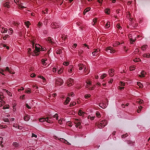“We found antimalarial use from six months prior to a visit protected against an increase in damage, even in the face of high-dose prednisone and cyclophosphamide, which illustrated a window of protection,” Dr. Silverman says. “We were able to show the protective effects were continued six months after exposure, illustrating that in order to achieve sustained benefits, physicians need to encourage long-term adherence to antimalarials.”
Dr. Silverman noted that although the study had no surprises, it did validate the researchers’ clinical intuition. He says his team hopes to perform follow-up studies and believes their research can be reproduced in other cohorts.
“Some of the patients were followed for 20 years, but the median was five years, which emphasizes the need for future studies,” Dr. Silverman says. “We also found that Afro-Caribbean patients, who have been known to [suffer] more SLE damage, also have a higher damage trajectory that started early compared to Caucasians and Asians.”
Among other notable findings, the study found acute confusion, lupus headache or fever predicted a subsequent increase in the damage trajectory, and active SLE, independent of steroids, was identified as a risk factor for avascular necrosis.
Ultimately, the researchers hope once their research is validated in independent cohorts, it will help rheumatologists determine the best patient management strategies to reduce the risk of organ damage.
“For instance, [patients] destined to have disease refractory to current standards of treatment might be considered for newer therapies,” Dr. Silverman says. “And for those with low-grade disease activity, attention should be paid to continue closely monitoring their condition.”
Unlike rheumatoid arthritis, in which flares cause obvious symptoms, such as an increase in joint pain, joint swelling and fatigue, SLE can lead to silent flares detected only by ongoing bloodwork, says Dr. Silverman.
“There are currently no guidelines for how often SLE patients should be
tested, but doing bloodwork every three to four months at a minimum is a good baseline to prevent complications,” Dr. Silverman says.
Linda Childers is a health writer located in the San Francisco Bay Area.
References
1. Lim LSH, Pullenayegum E, Feldman BM, et al. From childhood to adulthood: Disease activity trajectories in childhood-onset systemic lupus erythematosus. Arthritis Care Res (Hoboken). 2018 May;70(5):750–757.

